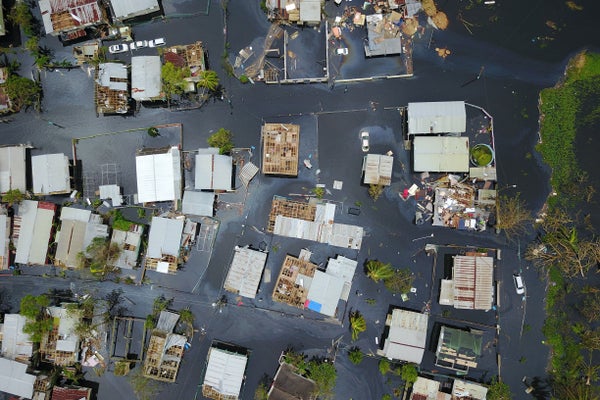Nearly a half-million people, mostly from the world’s poorest countries, died over the past two decades from conditions associated with climate disasters, according to new findings from the nonprofit Germanwatch.
In its annual “Global Climate Risk Index” report released this week, Germanwatch identified Puerto Rico, a U.S. territory, as suffering the greatest impacts from such disasters from 2000 to 2019.
It was followed by Myanmar in Southeast Asia and Haiti, just 700 nautical miles from the Florida Keys, and where tropical storms and other climate stressors threaten to compound long-standing political, economic, environmental and health crises affecting the country.
On supporting science journalism
If you're enjoying this article, consider supporting our award-winning journalism by subscribing. By purchasing a subscription you are helping to ensure the future of impactful stories about the discoveries and ideas shaping our world today.
Rounding out the top 10 for climate disasters between 2000 and 2019 were the Philippines, Mozambique, the Bahamas, Bangladesh, Pakistan, Thailand and Nepal. Total losses from countries analyzed were estimated at $2.5 trillion.
For the first time, the index does not include the United States beyond Puerto Rico because the underlying database lacked information about the U.S., the authors said. Data from Puerto Rico was collected independently, according to Germanwatch.
Wealthy countries like the U.S. and many European countries face significant climate risk, the group said, but generally have greater resources to blunt those impacts and implement risk reduction strategies.
“Developed countries are also affected, and they have to ramp up their mitigation and adaptation action very urgently. However, developing countries suffer much more existentially from the impacts of extreme weather events,” Vera Künzel, a Germanwatch senior adviser for climate change adaptation and human rights, said in a Monday press briefing from Germany.
In its 2020 report, the United States ranked 27th among all countries for climate disaster impacts between 1999 and 2018. Had U.S. data been included in the 2021 report, the financial losses from extreme events would have been roughly $1 trillion higher.
As in prior years, the 2021 report is based on data from Munich Re, one of the world’s largest reinsurers. The analysis accounts for events such as storms, floods and heat waves but does not include “slow-onset risks” such as sea-level rise, ocean warming and glacial melting, said David Eckstein, a report co-author and Germanwatch policy adviser on climate finance and investment.
There were roughly 11,000 extreme weather disasters worldwide between 2000 and 2019. Those events caused roughly 475,000 deaths and $2.5 trillion in economic losses for more than 160 countries.
For the single year 2019, half of the 10 countries most affected by extreme weather are categorized as low- to lower middle-income countries, based on U.N. classifications. The greatest climate impacts for that year were felt in Mozambique, Zimbabwe and the Bahamas, all of which suffered severe losses from storms, according to Germanwatch.
While the index reveals much about the effects of climate warming across every continent, it also provides a policy signal to the Biden administration as the United States looks to restore its standing among climate-engaged nations.
Alice Hill, a climate resilience expert and senior fellow for energy and the environment at the Council on Foreign Relations, said the mass disruption caused by extreme events, especially developing nations, has national security implications for the United States. That’s because governments can be destabilized by natural disasters, often leading to broader political, social and economic problems.
“These are human security issues,” Hill said. “If a government fails in its response, it opens windows of opportunity for bad actors, organized crime and corrupt individuals. It’s in our self-interest to lend a helping hand to less-developed nations.”
Human displacement caused by extreme events can also trigger tension between nations as “survivor migrants” flee areas destroyed by storms, floods, droughts and other disasters.
Eckstein cautioned that the index relies on data from past events and is not intended to make projections about future climate scenarios.
“Nevertheless, the index shows a strong story and shows a level of exposure and vulnerability to extreme weather events that countries should understand as a warning signal,” he said.
Reprinted from E&E News with permission from POLITICO, LLC. Copyright 2021. E&E News provides essential news for energy and environment professionals.
